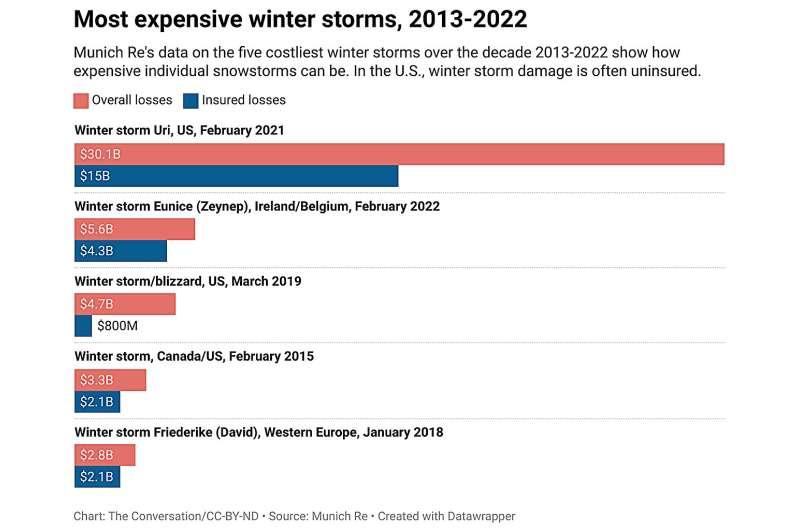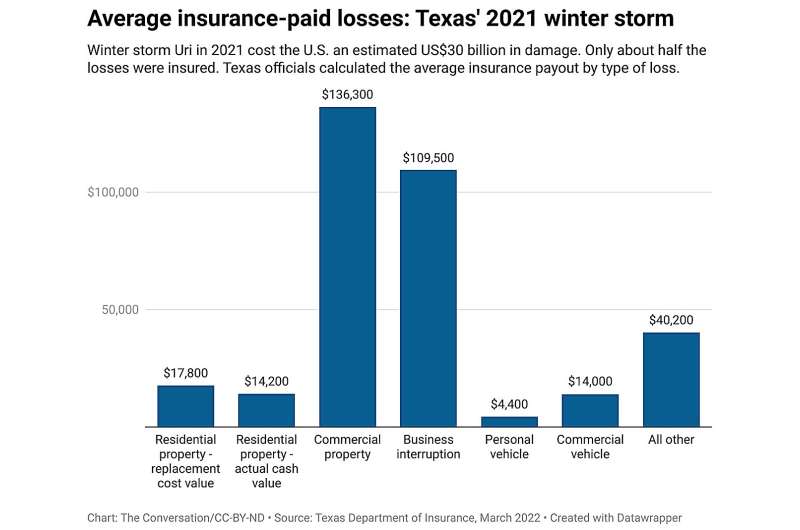
Winter storms can easily become billion-dollar disasters as the snow piles up on interstates and collapses roofs and power lines. Yet, while canceled flights and business interruptions can't be avoided, what turns a snowstorm into a disaster often can be.
I have worked on engineering strategies to enhance disaster resilience for over three decades and recently wrote a book, "The Blessings of Disaster," about the gambles humans take with disaster risk. Snowstorms stand out for how preventable much of the damage really is.
Stay off the roads
The easiest storm costs to avoid involve human behavior, including driving during snowstorms.
Successfully plowing the snow off a highway requires repeated passes to prevent snow from accumulating to the point where it piles up faster than it can be removed. However, that simple concept breaks down when an accident blocks the lanes, and traffic—including commerce and emergency vehicles—grinds to a halt.
When it takes snowmobiles to reach stranded drivers, the wait can be long and in some cases lethal. Hundreds of people were stranded for up to 24 hours on Interstate 95 during a snowstorm in Virginia in 2022.
Unfortunately, partly due to economic pressures, many people won't stay home during a blizzard unless authorities close the roads or impose driving bans. Those who venture out should be prepared to survive hours in the cold and have proper gear to avoid freezing to death. It's one reason the fad of wearing shorts, T-shirt and flip-flops in winter is ill-advised.
Pay attention to roofs
One snowflake at a time, wet snow can pile up to a weight of 30 pounds per cubic foot on a rooftop—enough to collapse a structure that is too light or not well designed. Although roof collapses are relatively rare, they are expensive and can take months to repair.
How snow builds up on a roof depends on a variety of factors, including the height of the snow accumulation and whether anything prevents the snow from blowing or sliding away.
Building codes specify the minimum snow weights that roofs must be able to handle to be safe. These have been updated over decades to minimize the risk of roofs failing, and they are still improving.
The national maps used to compute minimum snow loads were updated in 2022 to include 30 years of additional snow load data. As a result, the amount of snow that new building designs should be able to handle is up to 80% larger than before in some locations and as much as 40% less in others. For example, snow loads for new construction in New York City; Baltimore; Washington, D.C.; Reno, Nevada; Casper, Wyoming; and Beckley, West Virginia, are all significantly higher now than in the past.

Unfortunately, many cities and states have no buildings codes or have outdated ones. In 2022, the Federal Emergency Management Agency scored each state based on the stringency of its building codes on a 100-point scale, and 19 states received a score of 0.
To help them improve, FEMA is offering every state $2 million this year to spend on enhancing its existing codes, studying new codes or training employees in using codes.
Better building codes help improve new construction, but older homes and buildings may still be at risk of a possible roof collapse during a heavy snowstorm.
Homeowners and business owners have a few options: Invest in an engineering assessment of the existing roof and then strengthen the roof if needed. Have a team on standby to shovel snow off the roof, which can be dangerous and a major undertaking for the flat roofs of large warehouse and industrial facilities, for example. Or gamble on insurance covering the full cost of repairs.
Prepare for power outages
When it comes to infrastructure failure during snowstorms, power outages can be the biggest problem.
In 1998, an ice storm dumped freezing rain and drizzle for more than 80 hours on parts of eastern Canada and the Northeastern United States. As ice accumulated to as much as 3 to 4 inches near Montreal, the weight snapped tree branches, caused power lines to collapse and crumpled hundreds of transmission towers, leaving more than 3 million people there without power for several days in early January. In large parts of Montreal's South Shore, 150,000 people were without power for up to three weeks following the storm.
Nearly everything today depends on reliable power—infrastructure systems, companies, vehicles and even agriculture. When the power failed during the 1998 storm, heating and ventilation systems stopped working. Pipes burst. Farm animals froze to death or died of asphyxiation by the thousands.
Winter storm Uri in 2021 was even more destructive, as it knocked out power in Texas and froze several other states, causing about US$30 billion in losses—only about half of that insured.
Many industry sectors depend on the existing power infrastructure and operate without redundancy that could keep them running when the power goes out. While these optimized systems are slim, efficient and cost-effective—all good things under normal operating conditions—they are not resilient. Resilience, which is the ability to withstand or to recover quickly from extreme events, benefits from having a Plan B ready to deploy.
Power utilities nationwide have tree-trimming programs to minimize the risk of storms bringing branches down on power lines, and some utilities are burying power lines, but power outages are still expected. Businesses and homeowners having a Plan B—such as backup generators, operated safely to avoid creating other deadly hazards such as fires and carbon monoxide poisoning—can minimize the risk of costly losses during a snowstorm or ice storm.
In short, staying off the roads, under a roof that can handle the snow loads, and being well prepared for what could be long power outages would help make snowstorms a day off rather than a disaster.
This article is republished from The Conversation under a Creative Commons license. Read the original article.![]()
Citation: Blizzards are inescapable, but the most expensive winter storm damage is largely preventable, says engineer (2024, January 11) retrieved 11 January 2024 from https://techxplore.com/news/2024-01-blizzards-inescapable-expensive-winter-storm.html
This document is subject to copyright. Apart from any fair dealing for the purpose of private study or research, no part may be reproduced without the written permission. The content is provided for information purposes only.
